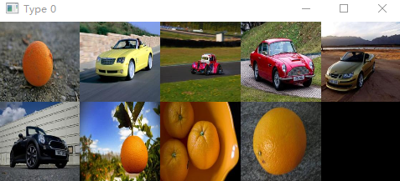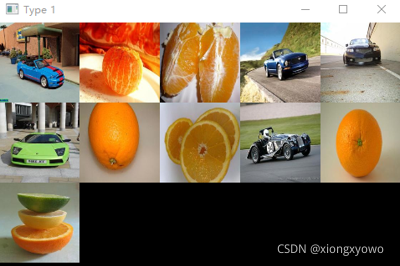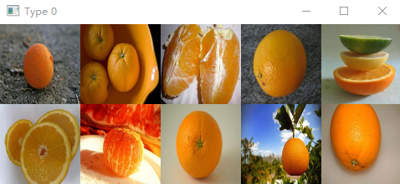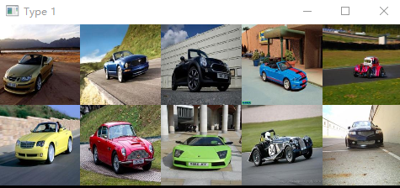您好,登錄后才能下訂單哦!
您好,登錄后才能下訂單哦!
這篇文章主要介紹“怎么用Python K-means實現簡單圖像聚類”,在日常操作中,相信很多人在怎么用Python K-means實現簡單圖像聚類問題上存在疑惑,小編查閱了各式資料,整理出簡單好用的操作方法,希望對大家解答”怎么用Python K-means實現簡單圖像聚類”的疑惑有所幫助!接下來,請跟著小編一起來學習吧!
這里直接給出第一個版本的直接實現:
import os
import numpy as np
from sklearn.cluster import KMeans
import cv2
from imutils import build_montages
import matplotlib.image as imgplt
image_path = []
all_images = []
images = os.listdir('./images')
for image_name in images:
image_path.append('./images/' + image_name)
for path in image_path:
image = imgplt.imread(path)
image = image.reshape(-1, )
all_images.append(image)
clt = KMeans(n_clusters=2)
clt.fit(all_images)
labelIDs = np.unique(clt.labels_)
for labelID in labelIDs:
idxs = np.where(clt.labels_ == labelID)[0]
idxs = np.random.choice(idxs, size=min(25, len(idxs)),
replace=False)
show_box = []
for i in idxs:
image = cv2.imread(image_path[i])
image = cv2.resize(image, (96, 96))
show_box.append(image)
montage = build_montages(show_box, (96, 96), (5, 5))[0]
title = "Type {}".format(labelID)
cv2.imshow(title, montage)
cv2.waitKey(0)主要需要注意的問題是對K-Means原理的理解。K-means做的是對向量的聚類,也就是說,假設要處理的是224×224×3的RGB圖像,那么就得先將其轉為1維的向量。在上面的做法里,我們是直接對其展平:
image = image.reshape(-1, )
那么這么做的缺陷也是十分明顯的。例如,對于兩張一模一樣的圖像,我們將前者向左平移一個像素。這么做下來后兩張圖像在感官上幾乎沒有任何區別,但由于整體平移會導致兩者的圖像矩陣逐像素比較的結果差異巨大。以橘子汽車聚類為例,實驗結果如下:


可以看到結果是比較差的。因此,我們進行改進,利用ResNet-50進行圖像特征的提取(embedding),在特征的基礎上聚類而非直接在像素上聚類,代碼如下:
import os
import numpy as np
from sklearn.cluster import KMeans
import cv2
from imutils import build_montages
import torch.nn as nn
import torchvision.models as models
from PIL import Image
from torchvision import transforms
class Net(nn.Module):
def __init__(self):
super(Net, self).__init__()
resnet50 = models.resnet50(pretrained=True)
self.resnet = nn.Sequential(resnet50.conv1,
resnet50.bn1,
resnet50.relu,
resnet50.maxpool,
resnet50.layer1,
resnet50.layer2,
resnet50.layer3,
resnet50.layer4)
def forward(self, x):
x = self.resnet(x)
return x
net = Net().eval()
image_path = []
all_images = []
images = os.listdir('./images')
for image_name in images:
image_path.append('./images/' + image_name)
for path in image_path:
image = Image.open(path).convert('RGB')
image = transforms.Resize([224,244])(image)
image = transforms.ToTensor()(image)
image = image.unsqueeze(0)
image = net(image)
image = image.reshape(-1, )
all_images.append(image.detach().numpy())
clt = KMeans(n_clusters=2)
clt.fit(all_images)
labelIDs = np.unique(clt.labels_)
for labelID in labelIDs:
idxs = np.where(clt.labels_ == labelID)[0]
idxs = np.random.choice(idxs, size=min(25, len(idxs)),
replace=False)
show_box = []
for i in idxs:
image = cv2.imread(image_path[i])
image = cv2.resize(image, (96, 96))
show_box.append(image)
montage = build_montages(show_box, (96, 96), (5, 5))[0]
title = "Type {}".format(labelID)
cv2.imshow(title, montage)
cv2.waitKey(0)可以發現結果明顯改善:


到此,關于“怎么用Python K-means實現簡單圖像聚類”的學習就結束了,希望能夠解決大家的疑惑。理論與實踐的搭配能更好的幫助大家學習,快去試試吧!若想繼續學習更多相關知識,請繼續關注億速云網站,小編會繼續努力為大家帶來更多實用的文章!
免責聲明:本站發布的內容(圖片、視頻和文字)以原創、轉載和分享為主,文章觀點不代表本網站立場,如果涉及侵權請聯系站長郵箱:is@yisu.com進行舉報,并提供相關證據,一經查實,將立刻刪除涉嫌侵權內容。